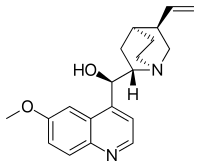
Photo from wikipedia
Abstract Food dye quinoline yellow (Qy) induced conformational change in bovine alpha-lactalbumin (αLA), and its interaction mechanism was investigated at physiological pH. We used several biophysical techniques (circular dichroism (CD),… Click to show full abstract
Abstract Food dye quinoline yellow (Qy) induced conformational change in bovine alpha-lactalbumin (αLA), and its interaction mechanism was investigated at physiological pH. We used several biophysical techniques (circular dichroism (CD), intrinsic fluorescence, UV–Vis absorption), and computational techniques (molecular docking and simulation). Our intrinsic fluorescence results suggested that Qy dye quenched the intrinsic fluorescence of αLA via a dynamic quenching mechanism because the quenching constant increased with elevation in temperature. We also found that αLA had one equivalent binding site for Qy dye, and that the affinity of Qy dye towards αLA was of the order of 105 mol/L. Thermodynamic analysis of αLA-Qy dye interactions revealed the spontaneous nature of such interactions. The positive values of enthalpy and entropy change explained that the interactions between Qy dye and αLA were driven mainly by hydrophobic interactions. The far-UV CD and UV-absorption results revealed that the αLA conformation changes because of Qy dye interactions. Molecular docking results indicated that Qy dye binds strongly at a major binding site of αLA and that αLA-Qy dye complex is stabilized by hydrogen bonding, salt bridge, Pi-cation, and van der Waals interaction. The molecular dynamics simulation study of αLA-Qy complexes revealed the formation of a stable interaction between them. This study can provide new insights into a comprehensive understanding of food dye-induced conformational changes in biological processes.
Journal Title: Journal of Molecular Liquids
Year Published: 2020
Link to full text (if available)
Share on Social Media: Sign Up to like & get
recommendations!